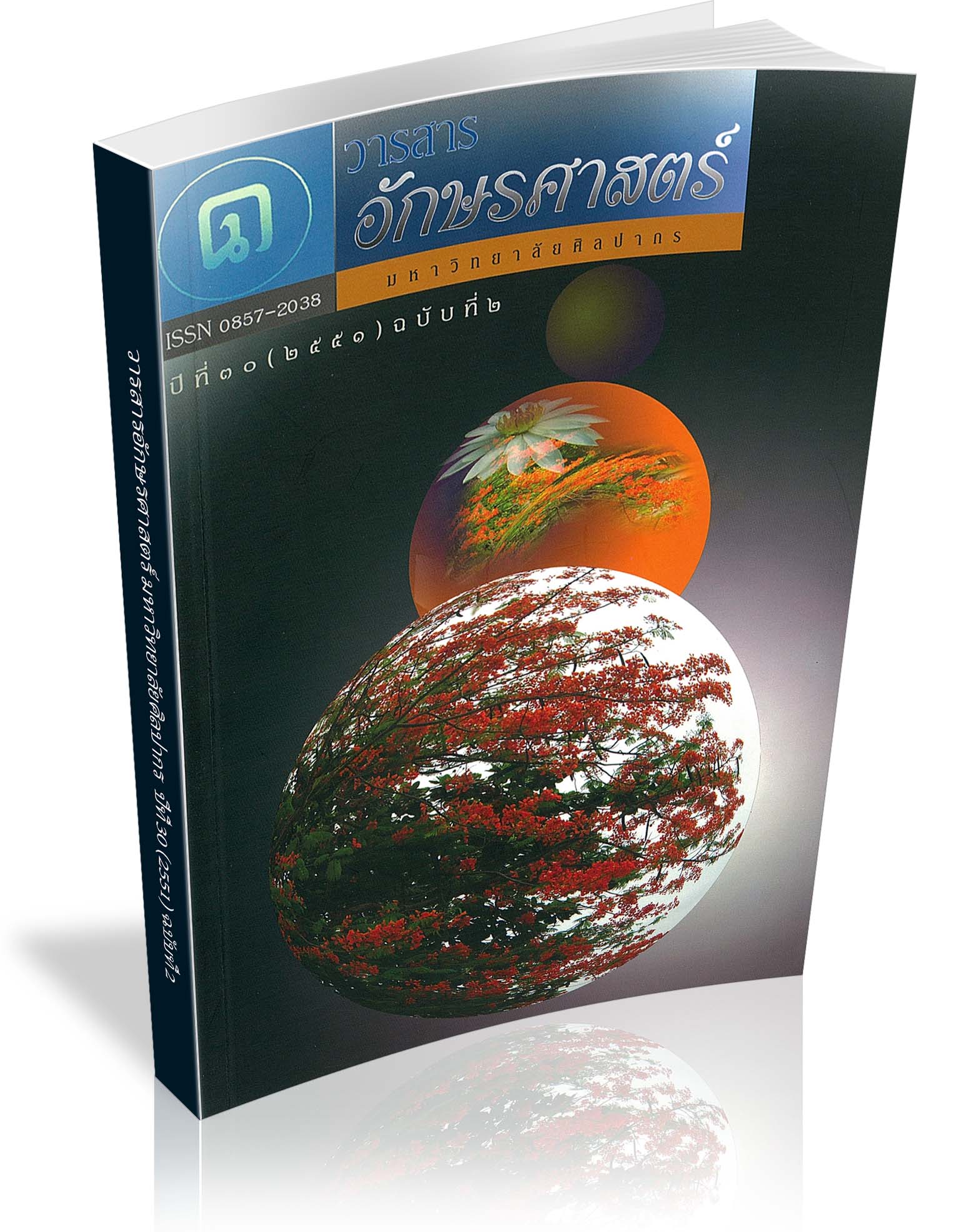Importance of Southern Thailand for The Japanes Army during The Greater East Asia War
Keywords:
Southern Thailand, Japanese army, Greater East Asia WarAbstract
This article has the objective of highlighting the importance of the southern region of Thailand as a strategic center for the Japanese army during the Greater East Asia War. An emphasis was placed on the southern railways, the most important railway line, which the Japanese army used as a means to transport military reinforcements, food supplies, and weapons and war equipment to bolster the Japanese army operating both in Burma and Malaya. During the Greater East Asia War, the Japanese army's exertion of their control over the southern railways manifested itself in two ways. First, special trains were employed to transport Japanese troops from Padang Besar to Alor-star, and from Sungei Golok to Kota Baru in Malaya. Second, by extending previously existing railways to Burma, two new railway tracks were constructed, namely, the Nong Pladuk-Kanchanaburi-Thanbyuzayat Railway (the Thailand Burma Railway) and the Chumphon-Kraburi Railway (the Kra Canal Railway). The control of Thailand's southern railways not only demonstrated the crucial role which the southern part of Thailand played during the Greater East Asia War, but also reflected the executed strategies that the Japanese army had so carefully planned in advance, so that Thailand had no option but to be compliant and submissive.
Downloads
References
____________. “บก.สูงสุด ๒.๔.๑/๕. เรื่อง ข้อเสนอการเดินรถขบวนทหารญี่ปุ่นออกนอกเขตแดนไทย.” ๒๐ เมษายน ๒๔๘๕.
____________. “บก.สูงสุด ๒.๔.๑/๒๓. เรื่อง ข้อตกลงการสร้างทางผ่านคอคอดกระ.” ๓๑ พฤษภาคม - ๑๕ มิถุนายน ๒๔๘๖.
กรมยุทธศึกษาทหาร. กองบัญชาการทหารสูงสุด. ประวัติศาสตร์การสงครามของไทย ในสงครามมหาเอเชียบูรพา. กรุงเทพฯ : อมรินทร์พรินเยิ่ง แอนด์ พับลิชชิ่ง, ๒๕๔๐.
แถมสุข นุ่มนนท์. “ไทยกับญี่ปุ่นสมัยสงครามโลกครั้งที่สอง : เมืองมิตรหรือเมืองขึ้น.” ใน การทูตไทยสมัยรัตนโกสินทร์. กรุงเทพฯ : ไทยวัฒนาพานิช, ๒๕๒๘.
นากามูระ, อาเคโตะ. บันทึกผู้บัญชาการกองทัพญี่ปุ่นประจำประเทศไทยเกี่ยวกับสงครามโลกครั้งที่ ๒. แปลโดย มราซิมา เออิจิ และนครินทร์ เมฆไตรรัตน์, กรุงเทพฯ : โรงพิมพ์มหาวิทยาลัยธรรมศาสตร์, ๒๕๓๔.
ชะโตโกะ, ทซึจิยะ. “ภาพลักษณ์ของยามาดา นางามาซา ในความสัมพันธ์ระหว่างประเทศไทยกับประเทศญี่ปุ่นในคริสต์ศตวรรษที่ ๒๐.” วิทยานิพนธ์ปริญญามหาบัณฑิต ภาควิชาประวัติศาสตร์ บัณฑิตวิทยาลัย จุฬาลงกรณ์มหาวิทยาลัย, ๒๕๔o.
นิภาพร รัตพัฒนากุล. “ความสัมพันธ์ทางวัฒนธรรมระหว่างไทย-ญี่ปุ่น พ.ศ. ๒๔๗๕ – ๒๔๘๘.” วิทยานิพนธ์ศิลปศาสตรมหาบัณฑิต ภาควิชาประวัติศาสตร์ บัณฑิตวิทยาลัย มหาวิทยาลัยธรรมศาสตร์, ๒๕๔๕.
พวงทิพย์ เกียรติสหกุล. “กองทัพญี่ปุ่นกับทางรถไฟสายใต้ของไทย สมัยสงครามมหาเอเชียบูรพา ระหว่าง พ.ศ. ๒๔๘๔-๒๔๘๘.” วิทยานิพนธ์อักษรศาสตรดุษฎีบัณฑิต ภาควิชาประวัติศาสตร์บัณฑิตวิทยาลัย จุฬาลงกรณ์มหาวิทยาลัย, ๒๕๔๗.
คุชิดะ มาซาโอะ. “เบื้องหลังการเข้าไปอย่างสันติของกองทหารญี่ปุ่นในประเทศไทย : ในช่วงต้นของการประกาศสงคราม (ธันวาคม ๒๔๘๔).” แปลและเรียบเรียงโดย มูราซิมา เออิจิ และ สรศักดิ์ งามขจรกลกิจ. เอกสารวิชาการไทย-ญี่ปุ่นศึกษา (เมษายน ๒๕๓๒) : ๗๔-๘๑.
ณรงค์ พ่วงพิศ. “ปัญหาเงินเยนพิเศษระหว่างประเทศไทยกับประเทศญี่ปุ่น (พ.ศ. ๒๔๘๔ - ๒๕๐๕ ).” วารสารประวัติศาสตร์ มหาวิทยาลัยศรีนครินทรวิโรฒ (๒๕๔๑) : ๖๕-๖๖.
แถมสุข นุ่มนนท์. “เมื่อประเทศไทยเข้าสู่สงครามโลกครั้งที่สอง.” วารสารประวัติศาสตร์ ๑, ๑ (มกราคม-เมษายน ๒๕๑๙) : ๑๔-๓๓.
Defense Agency, Defense Training Institute, Department of War History (ทบวงการป้องกันประเทศ สถาบันวิจัยป้องกัน แผนกประวัติศาสตร์สงคราม). Sen Sosho Sirarma Kouyaku Sakusen (ประวัติศาสตร์สงครามยุทธการโจมตีพม่า). Tokyo : Asakumo Shimbunsva, 1967.
Ota. Hirotake. "Nihon Senryoka no Maraya ni Okeru Tetsudo Unei Jijou" (สภาพการบริหารจัดการทางรถไฟในมลายูภายใต้การยึดครองของญี่ปุ่น). In Nihon Senryoka no Eiryo Maraya-Shingaporu (มลายูและสิงคโปร์ภายใต้การยึดครองของญี่ปุ่น), Edited by Akashi Yoji. Tokyo : Iwanamishoten, 2001.
Sanbo, Honbu, editor. Sugiyama Memo Jo (บันทึกสุงิยะมะ เล่มแรก), 2nd ed. Tokyo : Harashobo, 1994.
Lebra, C. Joyce. Japanese's Greater East Asia Co-Prosperity Sphere in World War || : Selected Readings and Documents. Kuala Lumpur : Oxford University, 1975.
Nobutaka, Ike, editor & translator. Japan's Decision For War : Records of the 1941 Policy Conferences. California : Standford University, 1967.
Renolds, E. Bruce. Thailand and Japan's Southern Advance, 1941–1945. New York : St. Martin's, 1994.
Downloads
Published
How to Cite
Issue
Section
License
ผู้เขียนบทความต้องยินยอมในข้อกำหนดต่าง ๆ ของวารสารก่อนส่งบทความตีพิมพ์




